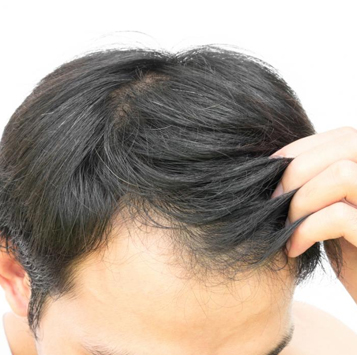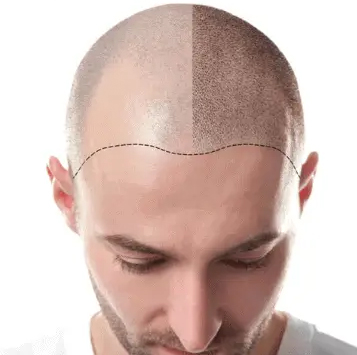Best Hair Treatment Clinic in Ghatkopar

Hair Regrowth Treatment
Hair regrowth can be achieved through various methods depending on the underlying cause of hair loss. Here are some possible ways to encourage hair regrowth:
1. Topical treatments: Topical treatments such as minoxidil can be applied directly to the scalp to promote hair regrowth. Minoxidil is available over-the-counter and works by increasing blood flow to hair follicles.
2. Prescription medications: Prescription medications such as finasteride may be prescribed by a doctor to help treat male pattern baldness. Finasteride works by blocking the conversion of testosterone to dihydrotestosterone (DHT), a hormone that can shrink hair follicles.
3. Hair transplant surgery: Hair transplant surgery involves moving hair from areas of the scalp where hair is abundant to areas where hair is thinning or missing. This method can be effective for people with pattern baldness.
4. Lifestyle changes: Making certain lifestyle changes such as reducing stress, eating a healthy diet, and getting regular exercise can help promote hair growth.
5. Laser therapy: Low-level laser therapy (LLLT) can be used to stimulate hair growth by increasing blood flow to hair follicles.

Dandruff and Scalp Care
Dandruff is a common condition that causes the scalp to become dry and flaky. It can be caused by a variety of factors, including dry skin, yeast overgrowth, and sensitivity to hair care products. Here are some tips for managing dandruff and caring for your scalp:
1. Use a gentle shampoo: Look for a shampoo that is specifically designed to treat dandruff. These shampoos typically contain active ingredients like salicylic acid, coal tar, or ketoconazole that can help reduce flakes and itchiness.
2. Avoid hot water: Hot water can dry out the scalp and make dandruff worse. Use lukewarm water when washing your hair and avoid using hot styling tools like hair dryers and straighteners.
3. Brush your hair: Brushing your hair regularly can help distribute natural oils and reduce the buildup of dead skin cells on the scalp.
4. Try a scalp treatment: There are several natural remedies that can help soothe an itchy, flaky scalp, including tea tree oil, aloe vera, and apple cider vinegar. These can be applied directly to the scalp or added to your shampoo.
5. Manage stress: Stress can trigger dandruff, so try to manage your stress levels through activities like exercise, meditation, or yoga.
6. Avoid harsh hair products: Some hair products can irritate the scalp and make dandruff worse. Avoid using products that contain alcohol, fragrances, or sulfates, and opt for gentle, natural products instead.

PRP for Hair Regrowth
PRP (platelet-rich plasma) therapy for hair regrowth has become a popular treatment option for people with hair loss. The procedure involves taking a small amount of the patient’s blood, processing it to separate the plasma, which is rich in platelets, and injecting the plasma into the scalp to stimulate hair growth.
Platelets contain growth factors that can help stimulate the regeneration of tissues and promote healing. When injected into the scalp, the growth factors in PRP can help to increase blood flow to hair follicles, prolong the growth phase of the hair cycle, and reduce inflammation, all of which can lead to thicker, healthier hair growth.
While there is some evidence to suggest that PRP therapy can be an effective treatment for hair loss, more research is needed to determine its long-term safety and effectiveness. PRP therapy is generally considered safe, although there may be some minor side effects such as swelling, bruising, or redness at the injection site.
PRP therapy is typically performed as a series of treatments spaced several weeks apart, and results may not be noticeable for several months. It’s important to note that PRP therapy may not be effective for all types of hair loss, and it’s best to consult with a dermatologist or hair restoration specialist to determine if it’s a good option for you.

Hair Transplant
A hair transplant is a surgical procedure that involves moving hair from one part of the scalp, typically the back or sides of the head, to another part of the scalp where hair is thinning or missing. Hair transplants are most commonly used to treat male pattern baldness, although they can also be used to restore hair growth in women and people with other types of hair loss.
There are two primary methods of hair transplant surgery:
1. Follicular unit transplantation (FUT): This method involves removing a strip of skin from the back of the scalp and dividing it into small grafts, each containing one to four hair follicles. The grafts are then transplanted into the recipient area, where they are carefully placed in tiny incisions made in the scalp.
2. Follicular unit extraction (FUE): This method involves harvesting individual hair follicles directly from the scalp using a small, handheld device. The follicles are then transplanted into the recipient area using the same method as in FUT.
Both FUT and FUE hair transplants are typically performed under local anesthesia and can take several hours to complete, depending on the extent of the procedure. The recovery period can vary, but most people are able to resume normal activities within a few days to a week after the procedure.
While hair transplant surgery can be an effective way to restore hair growth in people with hair loss, it’s important to note that not all people are good candidates for the procedure. It’s best to speak with a hair restoration specialist to determine if hair transplant surgery is a good option for you and to discuss the potential risks and benefits of the procedure.




